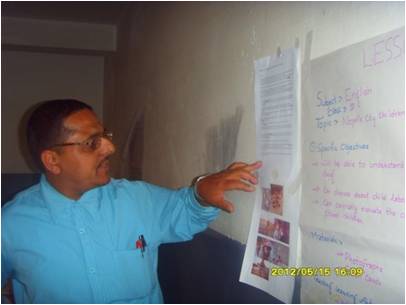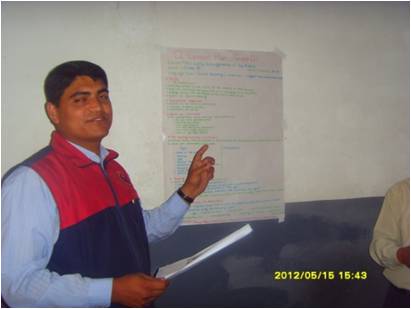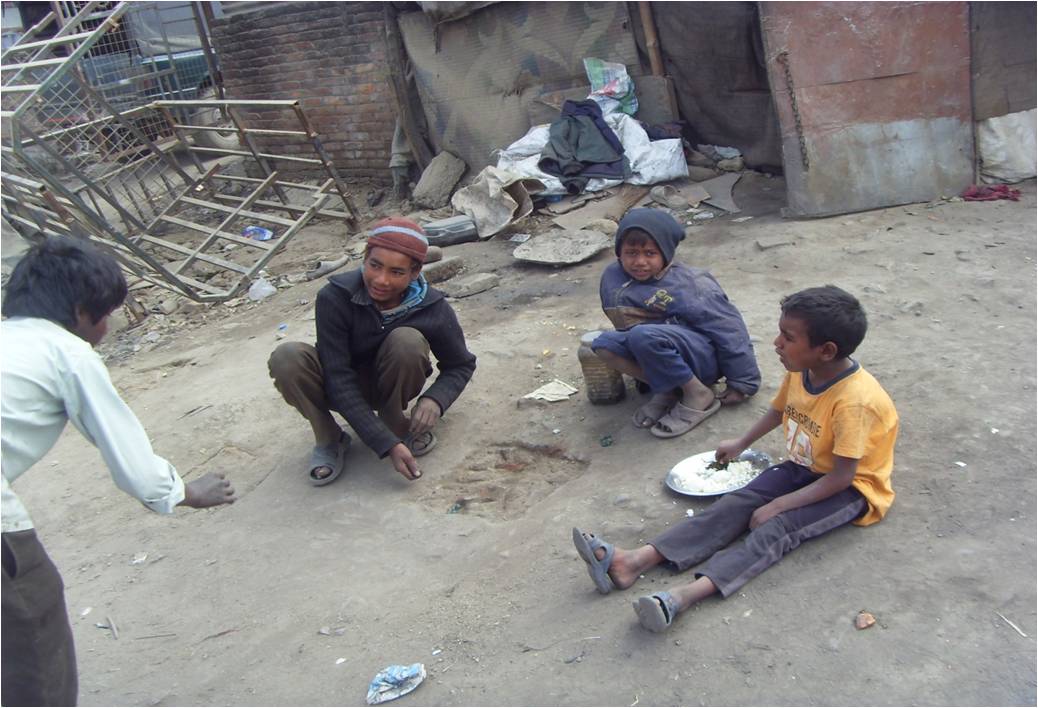Bal Krishna Sharma and Prem Phyak
On May 15, 2012, we facilitated a one-day workshop on ‘critical literacy in teaching English’ for secondary level teachers in Lalitpur. We had an enthusiastic group of 16 participants for the workshop organized by NELTA Lalitpur. There were two major goals of the workshop:
To understand the ways of linking authentic materials to local contexts in order to develop the students’ critical literacy skills.
To prepare and demonstrate a lesson plan that includes the use of locally available materials, addressing a critical social issue in Nepalese society, and demonstrates the teaching of language structure(s) (e.g. grammar, vocabulary, communication skills, etc.) based on the mandated secondary school level curriculum/textbook.
We went through the following stages in order to deliver the workshop.
- Materials preparation and evaluation: We (Bal Krishna Sharma and Prem Phyak) first independently worked on preparing materials. Bal Krishna prepared three English language lessons for teaching critical literacy: Domestic Child Labor, Women and Girls in Education and Dowry Practice. Pictures and essays were drawn from newspapers, magazines and other online sources. Prem drew on experiences from his previous workshop on critical literacy at NELTA Conference and a published article on NELTA’s Proceedings (co-authored with Rachel Bowden). Prem himself took a number of pictures of street children in Nepal, environment pollution in Kathmandu and prepared materials and lessons following OSDE methodology in order to train teachers at the workshop. Drawing ideas and materials from these two sources, we decided to train English teachers who were teaching English at secondary and post-secondary levels.
- Input: Before we engage the participants in actual activities and tasks, we thought that some theoretical and conceptual information on ‘critical’ pedagogy and literacy was essential. Our experience with similar workshops shows that the participants do want to ‘learn about’ recent developments and innovative ideas on English language teaching. Some of the questions that we asked the teachers to contemplate on as we worked on during the workshop were:
-
- What are some critical issues in teaching English as an international language?
- Are we isolating the students from or making them familiar with critical social issues while teaching English?
- Do the activities/texts/ methods we introduce in classrooms really encourage students to engage in dialogs?
- Do we try to explore diverse ideas or single (so-called right) idea from the students?
- Are we imposing teachers’ power or liberating students to come up with their own ideas?
We talked about Paulo Freire’s ideas on critical pedagogy and his criticisms of banking model of education (Freire, 1970). We made a distinction between traditional transmission model of education and relatively modern view of student-centered teaching. With the help of powerpoint slides, we explained different technical terms used in the field: critical pedagogy, feminist pedagogy, radical pedagogy, transformative pedagogy, and pedagogy of hope/possibility/empowerment (Wallace, 2003).
3. Issue Elicitation: It was necessary for the participants to remember that English teachers should not only be teaching grammar or vocabulary or language skills, but also be putting language in a broader Nepalese societal context and teaching critical social issues. We asked a question ‘What are some critical social issues in your locality?’ The participating teachers volunteered to mention social issues that are very much concerned about and are interested in addressing their English lessons. As they said, we noted them down on the board:
Gender inequality in education; Domestic violence; Dowry in marriage; Discrimination of gender at and after birth; Caste/ethnicity/class discrimination; Brain drain; Human trafficking; Cultural pollution/ degradation/ imperialism; kidnapping ; Poverty; Child labor; drug addiction; superstition; sexual harassment; global warming; bullying; cyber bullying; corruption; unemployment; price hike; energy crisis Then, as part of a mini-task, we asked the participants to read a text on child labor from a national daily The Kathmandu Post: No festive season cheer for domestic child workers and gave the following instructions:
-Read the text and prepare one critical reading question that you can ask your students.
-Share with your group members and discuss how you can make your questions more engaging and critical.
-Choose one question to share with the whole group.
We visited individual groups and overheard what they were talking about. They were discussing how they could make the questions more ‘critical’. Following are the questions that each group shared.
How could you react if a similar situation happens to you at the age of 16?
Why is Sanju Shrestha unable to go home to celebrate Dashain?
Why do you think Sanju does not feel good?
Is the mistress doing good for Sanju? Why (not)?
In addition to these questions, group discussions showed that the following language items can be taught:
| vocabulary: fragrance, activities, leisure, privilege, monitor, flashcards, phonetics, meaning, synonyms, use in a sentence |
narration/reported speech: underline,
voice: helping verbs and active and passive: underline;
Expressing likes and dislikes: elicitation; underline; compare and make them work in pair or group
We followed a similar process using the following picture asked a similar question: “How will you use this picture in your class? What language item can you teach?”
4. Reading a Sample Lesson Plan on Critical Literacy:
Then we asked the participants to read a lesson plan on Gender differences in schooling and occupation. Since we wanted the participants to have a thorough reading of the lesson plan, we prepared a set of guidelines to help them focus on each component:
| What are the teaching items for this lesson? (page 1 top) |
What are the SLOs and instructional materials?
What are the main components of the lesson plan?
What activities, materials, and SLOs are mentioned in the lesson?
What do pre-reading activities include (page 2-4)? Fill out some slots in page 2, 3 and 4.
What activities are used for the reading text?
What grammar items are focused in this lesson?
What makes this lesson more interactive? How does this address critical literacy issue?
This sample lesson plan reading activity started with an individual reading followed by pair and group discussions. We visited individual groups to see if they have any questions.
5. Preparation of a Lesson Plan:
Obviously we wanted to let the participants choose a critical social issue on their own and prepare a lesson plan based on that. However, neither we nor the participants had materials necessary for any open-ended issues. We grouped the participants into four and provided them with the pictures (one example is given below. We took this picture from The Kathmandu Post) and reading texts. Here are four themes and some pictures we provided: street children, elderly population, pollution, witchcraft practice. 
The participants were expected to start with Student Learning Outcomes and work on detailed components of a lesson plan for a 45-minute class, keeping the language and social background of their students. Each group engaged in discussions and each decided to teach different language skills/aspects while simultaneously teaching a critical social issue. Here are some pictures from the event: 



6. Why This?
Classroom teaching in Nepal strictly follows prescribed textbooks because students are tested from the textbooks at the end of the academic year. While the English medium private schools make use of textbooks published by international publishing houses like Oxford, Cambridge and Longman, government-aided public schools use textbooks approved and published by the Ministry of Education. These textbooks make very little attempt to encourage local teachers to design their own materials that supplement the textbook topics. There is enough room to contextualize the materials and activities in the textbooks that make connection with the learner’s everybody life in their community. This workshop illustrates that it is possible to teach, for example, vocabulary and grammar and other language skills by linking them to broader societal contexts that the learners are part of. When the teachers include a critical literacy component in their teaching, students do not only engage with language practice; they in fact can constantly take part in making discourses that question or negotiate the power and hegemony persistent in their societies.
Here is a response from one of the participants.
I learned how to make students active and enthusiastic to read a text themselves. I knew how to engage students in asking and responding critical questions. …. I learned how to organize group works to promote classroom interaction. We can teach grammar from the text (which is related to a critical social issue). We can collect the individual report and share their knowledge among their friends through critical discussion. It helps them to experience a friendly environment in the classroom. I learned how to make an effective lesson plan within a fixed time. The workshop provided me an opportunity with designing a lesson plan in collaboration with friends. I also learned how to make lesson plans objective oriented and demonstrate them before they are really used in the classroom. Now I feel comfortable to teach in classroom with a lot of contextualization. My students too feel so happy to read actively and creatively. It makes my students curious to know more about their society and interested to share their views in the classroom.
References
Freire, P. (1970). Pedagogy of the oppressed (MB Ramos, Trans.). New York: Continuum, 2007.
Wallace, C. (2003). Critical Pedagogy for language teaching. In Critical Reading in Language Education (pp. 49-78). Palgrave Macmillan, London.

Very important theme. Thanks Balkrishna and prem Jees!
The issue raised by two tutors (Bal Krishna Sharma and Prem Phyak) on critical literacy is really a burning issue. It is now time for a teacher and educational stakeholders to think one step ahead. Only content knowledge and four skills comprehensions are not enough for students. Teaching needs to be based on critical pedagogy for all round development. So a teacher needs to address/incorporate contextual (fact based) issues while teaching and the workshop itself was a very good example of it. Thank you